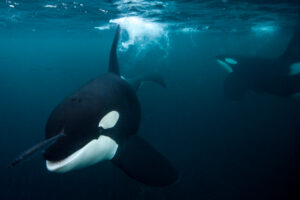Almost like a living creature, she resisted the forces”
We faced the month of October with anxious hearts,” said Ernest Shackleton on the last day of September 1915 in his book, South!, when the ship withstood serious pressure from the ice in the Weddell Sea.
Floes were moving. Frost-smoke from opening cracks was showing in all directions during October 6th. Temperatures were rising. Many seals, penguins, and even whales disporting themselves in the leads
At 7 p.m. on the 13th the ship broke free of the floe on which she had rested to starboard sufficiently to come upright. The rudder freed itself, but the propeller was found to be athwartship, having been forced into that position by the floe some time after August 1, explained Shackleton.
Temperatures were falling again. On October 17th, heavy pressure developed. The two floes between which the Endurance was lying began to close and the ship was subjected to a series of tremendously heavy strains. “She lifted ten inches forward and three feet four inches aft, at the same time heeling six degrees to port. The ice was getting below us and the immediate danger had passed.”
The next attack of the ice came on the afternoon of October 18th. Within a few seconds the ship heeled over until she had a list of thirty degrees to port, being held under the starboard bilge by the opposing floe. Everything movable on deck and below fell to the lee side, and for a few minutes it looked as if the Endurance would be thrown upon her beam ends. Order was soon restored. Shackleton had all fires put out and battens nailed on the deck to give the dogs a foothold and enable people to get about. Then the crew lashed all the movable gear.
At 8 p.m. the floes opened, and within a few minutes the Endurance was nearly upright again. Orders were given for the ice to be chipped clear of the rudder.
October 19: The barometer at 11 p.m. stood at 28.96, the lowest since the gales of July.
October 20 and the pack was working. The Endurance was imprisoned securely in the pool. Watches were set so as to be ready for working ship. Wild and Hudson, Greenstreet and Cheetham, Worsley and Crean, took the deck watches. “At 11 a.m. we gave the engines a gentle trial turn astern. Everything worked well after eight months of frozen inactivity, except that the bilge-pump and the discharge proved to be frozen up; they were cleared with some little difficulty. The engineer reported that to get steam he had used one ton of coal, with wood-ashes and blubber. The fires required to keep the boiler warm consumed one and a quarter to one and a half hundred-weight of coal per day. We had about fifty tons of coal remaining in the bunkers.”
October 21 and 22 were days of low temperature, which caused the open leads to freeze over. The pack was working, and ever and anon the roar of pressure came to our ears. The 23rd brought a strong north-westerly wind.
On Sunday, October 24, there came what for the Endurance was the beginning of the end. The position was lat. 69° 11´ S., long. 51° 5´ W. They had now twenty-two and a half hours of daylight. “The onslaught was all but irresistible,” wrote Shackleton. “The Endurance groaned and quivered as her starboard quarter was forced against the floe, twisting the sternpost and starting the heads and ends of planking. The ice had lateral as well as forward movement, and the ship was twisted and actually bent by the stresses. She began to leak dangerously at once.”
“I had the pumps rigged, got up steam, and started the bilge-pumps at 8 p.m. The pressure by that time had relaxed. The ship was making water rapidly aft, and the carpenter set to work to make a coffer-dam astern of the engines. All hands worked, watch and watch, throughout the night, pumping ship and helping the carpenter. By morning the leak was being kept in check.
October 25th, the leak was being kept under fairly easily, but the outlook was bad. Heavy pressure-ridges were forming in all directions.”
“Huge blocks of ice, weighing many tons, were lifted into the air and tossed aside as other masses rose beneath them. We were helpless intruders in a strange world, our lives dependent upon the play of grim elementary forces that made a mock of our puny efforts.” Stores, dogs, sledges, and equipment were ready to be moved from the ship at a moment’s notice.
The following day (October 26) brought bright clear weather, but at 7 pm a very heavy pressure developed. “Almost like a living creature, she resisted the forces that would crush her; but it was a one-sided battle. Millions of tons of ice pressed inexorably upon the little ship that had dared the challenge of the Antarctic. The Endurance was now leaking badly, and at 9 p.m. Shackleton gave the order to lower boats, gear, provisions, and sledges to the floe, and move them to the flat ice a little way from the ship.
“The working of the ice closed the leaks slightly at midnight, but all hands were pumping all night. A strange occurrence was the sudden appearance of eight emperor penguins from a crack 100 yds. away at the moment when the pressure upon the ship was at its climax. They walked a little way towards us, halted, and after a few ordinary calls proceeded to utter weird cries that sounded like a dirge for the ship. None of us had ever before heard the emperors utter any other than the most simple calls or cries, and the effect of this concerted effort was almost startling.”
Read more about the 27th on the 27th.
#Shackleton #Endurance #hundredyearsago
Previous: Shackleton September 1915: Silent Bergs and Grining Floes…






